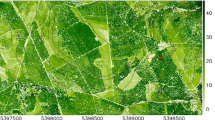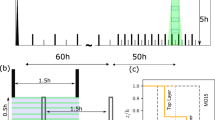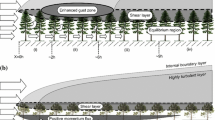Abstract
Applications of flow models to tall plant canopies are limited, amongst other factors, by the lack of detailed information on vegetation structure. A method is presented to record 3D vegetation structure and make this information applicable to the derivation of turbulence parameters suitable for flow models. The relationship between wind speed, drag coefficient (C D ) and plant area density (PAD) was experimentally investigated in a mixed conifer forest in the lower part of the Eastern Ore Mountains. Essential information was gathered by collecting multi-level high-frequency wind velocity measurements and a dense 3D representation of the forest was obtained from terrestrial laser scanner data. Wind speed dependence or streamlining was observed for most of the wind directions. Edge effects, i.e. the influence of the here not regarded pressure gradient and the advective terms of the momentum equation, are assumed to cause this heterogeneity. Contrary to the hypothetic shelter effect, which would reduce the drag on sheltered plant parts, the calculated profiles of drag coefficients revealed an increasing C D with PAD (i.e. a dependence on canopy and plant structure).












Similar content being viewed by others
References
Amiro BD (1990) Drag coefficients and turbulence spectra within three boreal forest canopies. Bound-Layer Meteorol 52:227–246
Arya SP (2001) Introduction to micrometeorology. Academic Press, London
Aschoff T, Spiecker H (2004) Algorithms for the automatic detection of trees in laser scanner data. In: Thies M, Koch B, Spiecker H, Weinacker H (eds) International society of photogrammetry and remote sensing, Freiburg, pp 66–70
Aschoff T, Holderied M, Spiecker H (2006) Forstliche Maßnahmen zur Verbesserung von Jagdlebensräumen von Fledermäusen. In: Luhmann T, Müller C (eds) Photogrammetrie—laserscanning—optische 3D-Messtechnik. Beiträge Oldenburger 3D-Tage 2006. Verlag Herbert Eichmann, Heidelberg, pp 280–287
Aubinet M, Heinesch B, Bernhofer C, Canepa E, Lindroth A, Montagnani L, Rebmann C, Sedlak P, van Gorsel E (2010) Direct advection measurements do not help to solve the night-time CO2 closure problem: evidence from three different forests. Agric For Meteorol 150:655–664
Ayotte KW, Finnigan JJ, Raupach MR (1999) A second-order closure for neutrally stratified vegetative canopy flows. Bound-Layer Meteorol 90:189–216
Bienert A, Queck R, Schmidt A, Bernhofer C, Maas H-G (2010) Voxel space analysis of terrestrial laser scans in forests for wind field modelling. IAPRS XXXVIII(5):92–97
Brunet Y, Finnigan JJ, Raupach MR (1994) A wind tunnel study of air flow in waving wheat: single-point velocity statistics. Bound-Layer Meteorol 70:95–132
Cava D, Katul GG (2008) Spectral short-circuiting and wake production within the canopy trunk space of an alpine hardwood forest. Bound-Layer Meteorol 126:415–431
Cescatti A, Marcolla B (2004) Drag coefficient and turbulence intensity in conifer canopies. Agric For Meteorol 121:197–206
Coppin PA, Raupach MR, Legg BJ (1986) Experiments on scalar dispersion within a model plant canopy part II: an elevated plane source. Bound-Layer Meteorol 35:167–191
de Langre E (2008) Effects of wind on plants. Annu Rev Fluid Mech 40:141–168
Dupont S, Bonnefond J-M, Irvine MR, Lamaud E, Brunet Y (2011) Long-distance edge effects in a pine forest with a deep and sparse trunk space: in situ and numerical experiments. Agric For Meteorol 151:328–344
Feigenwinter C, Bernhofer C, Vogt R (2004) The influence of advection on the short term CO2-budget in and above a forest canopy. Bound-Layer Meteorol 113:201–224
Finnigan JJ (2000) Turbulence in plant canopies. Annu Rev Fluid Mech 32:519–571
Frank C, Ruck B (2008) Numerical study of the airflow over forest clearings. Forestry 81:1–19
Gorte B, Pfeifer N (2004) Structuring laser-scanned trees using 3D mathematical morphology. In Istanbul, Turkey, pp 929–933
Groß G (1993) Numerical simulation of canopy flows. Springer, New York
Grünwald T, Bernhofer C (2007) A decade of carbon, water and energy flux measurements of an old spruce forest at the Anchor Station Tharandt. Tellus B 59:387–396
Halldin S, Lindroth A (1986) Pine forest microclimate simulation using different diffusivities. Bound-Layer Meteorol 35:103–123
Hasager CB, Jensen NO (1999) Surface-flux aggregation in heterogeneous terrain. Q J R Meteorol Soc 125:2075–2102
Henning JG, Radtke PJ (2006) Detailed stem measurements of standing trees from ground-based scanning lidar. For Sci 52:67–80
Kaimal JC, Finnigan JJ (1994) Atmospheric boundary layer flows: their structure and measurement. Oxford University Press, Oxford
Kerzenmacher T, Gardiner B (1998) A mathematical model to describe the dynamic response of a spruce tree to the wind. Trees 12:385–394
Koizumi A, Motoyama J-i, Sawata K, Sasaki Y, Hirai T (2010) Evaluation of drag coefficients of poplar-tree crowns by a field test method. J Wood Sci 56:189–193
Kraus K, Pfeifer N (2001) Advanced DTM generation from LIDAR data. IAPRS 34:23–30
Landsberg JJ, Thom AS (1971) Aerodynamic properties of a plant of complex structure. Q J R Meteorol Soc 97:565–570
Lefsky M, McHale M (2008) Volume estimates of trees with complex architecture from terrestrial laser scanning. J Appl Remote Sens 2(1):1–19
Li ZJ, Miller DR, Lin JD (1985) A first-order closure scheme to describe counter-gradient momentum transport in plant canopies. Bound-Layer Meteorol 33:77–83
Maas H-G, Bienert A, Scheller S, Keane E (2008) Automatic forest inventory parameter determination from terrestrial laser scanner data. Int J Remote Sens 29:1579–1593
Mahrt L, Vickers D, Sun J, Jensen NO, Allen H, Pardyjak E, Fernando H (2001) Determination of the surface drag coefficient. Bound-Layer Meteorol 99:249–276
Marcolla B, Pitacco A, Cescatti A (2003) Canopy architecture and turbulence structure in a coniferous forest. Bound-Layer Meteorol 108:39–59
Massman WJ (1987) A comparative study of some mathematical models of the mean wind structure and aerodynamic drag of plant canopies. Bound-Layer Meteorol 40:179–197
Massman WJ (1997) An analytical one-dimensional model of momentum transfer by vegetation of arbitrary structure. Bound-Layer Meteorol 83:407–421
Monteith JL, Unsworth MH (2008) Principles of environmental physics. Academic Press, London
Pfeifer N, Winterhalder D (2004) Modelling of tree cross sections from terrestrial laser scanning data with free-form curves. IAPRS XXXVI—8/W2:76–81
Pinard JDJ-P, Wilson JD (2001) First- and second-order closure models for wind in a plant canopy. J Appl Meteorol 40:1762–1768
Queck R, Bernhofer C (2010) Constructing wind profiles in forests from limited measurements of wind and vegetation structure. Agric For Meteorol 150:724–735
Raupach MR, Shaw RH (1982) Averaging procedures for flow within vegetation canopies. Bound-Layer Meteorol 22:79–90
Raupach MR, Thom AS (1981) Turbulence in and above plant canopies. Annu Rev Fluid Mech 13:97–129
Shaw RH, Schumann U (1992) Large-eddy simulation of turbulent flow above and within a forest. Bound-Layer Meteorol 61:47–64
Sogachev A, Panferov O (2006) Modification of two-equation models to account for plant drag. Bound-Layer Meteorol 121:229–266
Stewart JB, Thom AS (1973) Energy budgets in pine forest. Q J R Meteorol Soc 99:154–170
Thom AS (1971) Momentum absorption by vegetation. Q J R Meteorol Soc 97:414–428
Vosselman G, Maas H-G (2010) Airborne and terrestrial laser scanning. Whittles Publishing, Dunbeath, Scotland, UK
Wilson NR, Shaw RH (1977) A higher order closure model for canopy flow. J Appl Meteorol 16:1197–1205
Wood CJ (1995) Understanding wind forces on trees. In: Coutts MP, Grace J (eds) Wind and trees. Cambridge University Press, Cambridge, pp 133–164
Yang B, Raupach MR, Shaw RH, Paw U KT, Morse A (2006) Large-eddy simulation of turbulent flow across a forest edge. Part I: flow statistics. Bound-Layer Meteorol 120:377–412
Acknowledgments
This study was supported by the ‘Deutsche Forschungsgemeinschaft’ (DFG SPP 1276 MetStröm) within the project ‘Turbulent Exchange processes between Forested areas and the Atmosphere’ (Grant BE 1721). We thank Dr. Christian Feigenwinter and Dr. Roland Vogt (University of Basel) for their logistical and scientific support and the technical staff of the Institute of Hydrology and Meteorology of the TUD. The authors would also like to thank Faro Europe GmbH for providing the laser scanner.
Author information
Authors and Affiliations
Corresponding author
Additional information
Communicated by J. Bauhus.
This article belongs to the special issue ‘Wind Effects on Trees’.
Rights and permissions
About this article
Cite this article
Queck, R., Bienert, A., Maas, HG. et al. Wind fields in heterogeneous conifer canopies: parameterisation of momentum absorption using high-resolution 3D vegetation scans. Eur J Forest Res 131, 165–176 (2012). https://doi.org/10.1007/s10342-011-0550-0
Received:
Revised:
Accepted:
Published:
Issue Date:
DOI: https://doi.org/10.1007/s10342-011-0550-0




